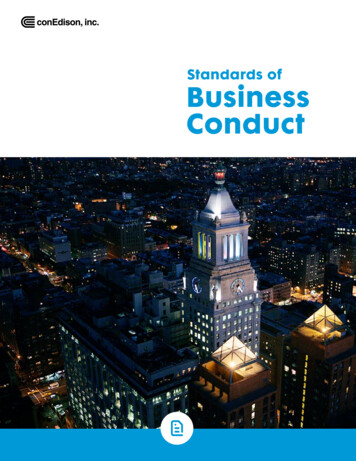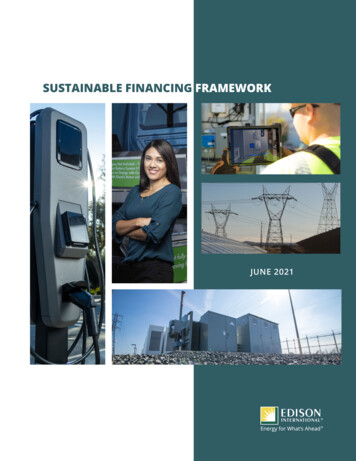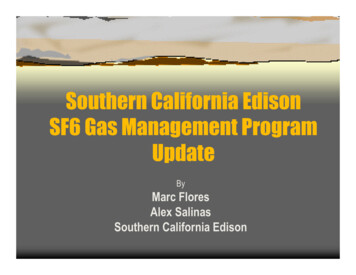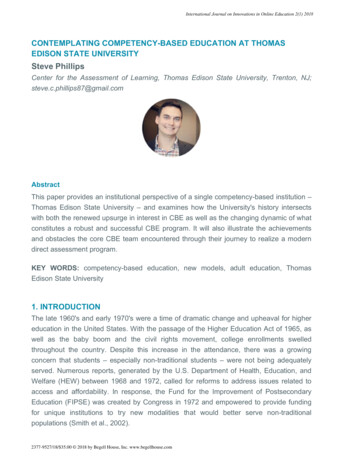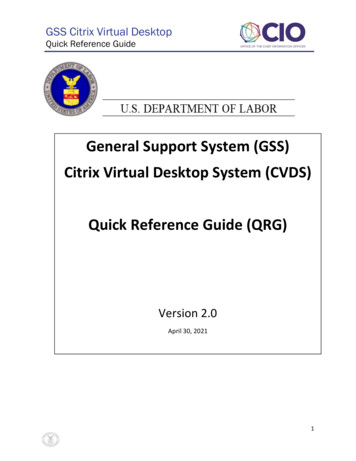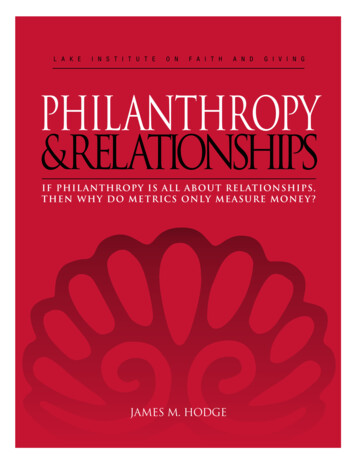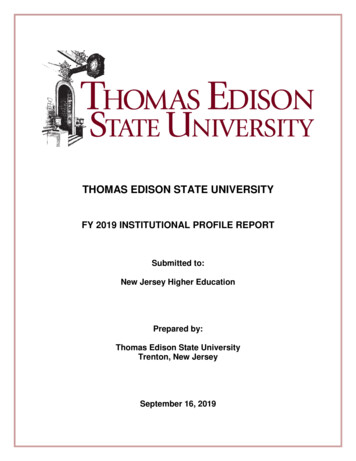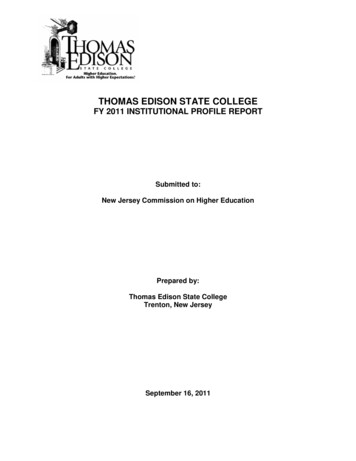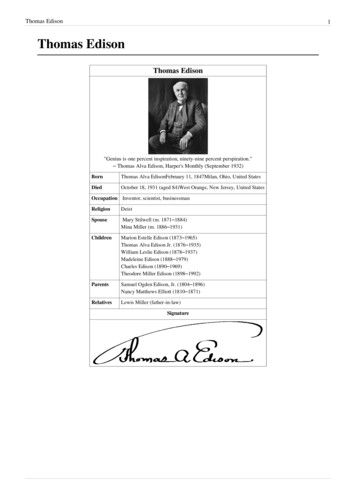
Transcription
Thomas Edison1Thomas EdisonThomas Edison"Genius is one percent inspiration, ninety-nine percent perspiration."– Thomas Alva Edison, Harper's Monthly (September 1932)BornThomas Alva EdisonFebruary 11, 1847Milan, Ohio, United StatesDiedOctober 18, 1931 (aged 84)West Orange, New Jersey, United StatesOccupation Inventor, scientist, businessmanReligionDeistSpouseMary Stilwell (m. 1871–1884)Mina Miller (m. 1886–1931)ChildrenMarion Estelle Edison (1873–1965)Thomas Alva Edison Jr. (1876–1935)William Leslie Edison (1878–1937)Madeleine Edison (1888–1979)Charles Edison (1890–1969)Theodore Miller Edison (1898–1992)ParentsSamuel Ogden Edison, Jr. (1804–1896)Nancy Matthews Elliott (1810–1871)RelativesLewis Miller (father-in-law)Signature
Thomas Edison2Thomas Alva Edison (February 11, 1847 – October 18, 1931) was anAmerican inventor, scientist, and businessman who developed manydevices that greatly influenced life around the world, including thephonograph, the motion picture camera, and a long-lasting, practicalelectric light bulb. Dubbed "The Wizard of Menlo Park" (now Edison,New Jersey) by a newspaper reporter, he was one of the first inventorsto apply the principles of mass production and large teamwork to theprocess of invention, and therefore is often credited with the creationof the first industrial research laboratory.[1]Birthplace of Thomas EdisonEdison is considered one of the most prolific inventors in history,holding 1,093 US patents in his name, as well as many patents in theUnited Kingdom, France, and Germany. He is credited with numerousinventions that contributed to mass communication and, in particular,telecommunications. These included a stock ticker, a mechanical voterecorder, a battery for an electric car, electrical power, recorded musicand motion pictures. His advanced work in these fields was anoutgrowth of his early career as a telegraph operator. Edison originatedthe concept and implementation of electric-power generation anddistribution to homes, businesses, and factories – a crucialdevelopment in the modern industrialized world. His first powerstation was on Manhattan Island, New York.Historical marker of Edison's birthplace in Milan,OhioEarly lifeThomas Edison was born in Milan, Ohio and grew up in Port Huron,Michigan. He was the seventh and last child of Samuel Ogden Edison,Jr. (1804–96, born in Marshalltown, Nova Scotia, Canada) and NancyMatthews Elliott (1810–1871).[2] His father had to escape from Canadabecause he took part in the unsuccessful Mackenzie Rebellion of 1837.Edison considered himself to be of Dutch ancestry.[3] In school, theyoung Edison's mind often wandered, and his teacher, the ReverendEngle, was overheard calling him "addled". This ended Edison's threemonths of official schooling. Edison recalled later, "My mother wasthe making of me. She was so true, so sure of me; and I felt I hadsomething to live for, someone I must not disappoint." His motherhomeschooled him.[4] Much of his education came from reading R.G.Parker's School of Natural Philosophy and The Cooper Union. Edisondeveloped hearing problems at an early age. The cause of his deafnesshas been attributed to a bout of scarlet fever during childhood andThomas Edison as a boyrecurring untreated middle-ear infections. Around the middle of hiscareer Edison attributed the hearing impairment to being struck on the ears by a train conductor when his chemicallaboratory in a boxcar caught fire and he was thrown off the train in Smiths Creek, Michigan, along with hisapparatus and chemicals. In his later years he modified the story to say the injury occurred when the conductor, inhelping him onto a moving train, lifted him by the ears.[5] [6] Edison's family was forced to move to Port Huron,Michigan, when the railroad bypassed Milan in 1854,[7] but his life there was bittersweet. He sold candy and
Thomas Edison3newspapers on trains running from Port Huron to Detroit, and he sold vegetables to supplement his income. Thisbegan Edison's long streak of entrepreneurial ventures as he discovered his talents as a businessman. These talentseventually led him to found 14 companies, including General Electric, which is still in existence and is one of thelargest publicly traded companies in the world.[8] [9]TelegrapherEdison became a telegraph operator after he saved three-year-old Jimmie MacKenzie from being struck by arunaway train. Jimmie's father, station agent J.U. MacKenzie of Mount Clemens, Michigan, was so grateful that hetrained Edison as a telegraph operator. Edison's first telegraphy job away from Port Huron was at Stratford Junction,Ontario, on the Grand Trunk Railway.[10] In 1866, at the age of 19, Thomas Edison moved to Louisville, Kentucky,where, as an employee of Western Union, he worked the Associated Press bureau news wire. Edison requested thenight shift, which allowed him plenty of time to spend at his two favorite pastimes—reading and experimenting.Eventually, the latter pre-occupation cost him his job. One night in 1867, he was working with a lead-acid batterywhen he spilled sulfuric acid onto the floor. It ran between the floorboards and onto his boss's desk below. The nextmorning Edison was fired.[11]One of his mentors during those early years was a fellow telegrapher and inventor named Franklin Leonard Pope,who allowed the impoverished youth to live and work in the basement of his Elizabeth, New Jersey home. Some ofEdison's earliest inventions were related to telegraphy, including a stock ticker. His first patent was for the electricvote recorder, (U. S. Patent 90,646),[12] which was granted on June 1, 1869.[13]Marriages and childrenOn December 25, 1871, Edison married 16-year-old Mary Stilwell,whom he had met two months earlier as she was an employee at one ofhis shops. They had three children: Marion Estelle Edison (1873–1965), nicknamed "Dot"[14] Thomas Alva Edison, Jr. (1876–1935), nicknamed "Dash"[15] William Leslie Edison (1878–1937) Inventor, graduate of theSheffield Scientific School at Yale, 1900.[16]Mary Edison died on August 9, 1884, possibly from a brain tumor.[17]On February 24, 1886, at the age of thirty nine, Edison married20-year-old Mina Miller in Akron, Ohio.[18] She was the daughter ofinventor Lewis Miller, co-founder of the Chautauqua Institution and abenefactor of Methodist charities. They also had three children: Madeleine Edison (1888–1979), who married John Eyre Sloane.[19][20] Charles Edison (1890–1969), who took over the company upon hisfather's death and who later was elected Governor of NewJersey.[21] He also took charge of his father's experimentallaboratories in West Orange.Mina Edison in 1906 Theodore Edison (1898–1992), (MIT Physics 1923), had over 80 patents to his credit.Mina outlived Thomas Edison, dying on August 24, 1947.[22] [23]
Thomas Edison4Beginning his careerThomas Edison began his career as an inventor in Newark, New Jersey, with theautomatic repeater and his other improved telegraphic devices, but the inventionwhich first gained him notice was the phonograph in 1877. This accomplishmentwas so unexpected by the public at large as to appear almost magical. Edisonbecame known as "The Wizard of Menlo Park," New Jersey. His firstphonograph recorded on tinfoil around a grooved cylinder, but had poor soundquality and the recordings could only be played a few times. In the 1880s, aredesigned model using wax-coated cardboard cylinders was produced byAlexander Graham Bell, Chichester Bell, and Charles Tainter. This was onereason that Thomas Edison continued work on his own "Perfected Phonograph."Menlo Park (1876–1881)Photograph of Edison with hisphonograph, taken by Mathew Bradyin 1877Edison's major innovation was the first industrial research lab, which was built inMenlo Park, New Jersey. It was built with the funds from the sale of Edison's quadruplex telegraph. After hisdemonstration of the telegraph, Edison was not sure that his original plan to sell it for 4,000 to 5,000 was right, sohe asked Western Union to make a bid. He was surprised to hear them offer 10,000, which he gratefully accepted.The quadruplex telegraph was Edison's first big financial success, and Menlo Park became the first institution set upwith the specific purpose of producing constant technological innovation and improvement. Edison was legallyattributed with most of the inventions produced there, though many employees carried out research and developmentunder his direction. His staff was generally told to carry out his directions in conducting research, and he drove themhard to produce results.William J. Hammer, a consulting electrical engineer, began his dutiesas a laboratory assistant to Edison in December 1879. He assisted inexperiments on the telephone, phonograph, electric railway, iron oreseparator, electric lighting, and other developing inventions. However,Hammer worked primarily on the incandescent electric lamp and wasput in charge of tests and records on that device. In 1880, he wasappointed chief engineer of the Edison Lamp Works. In his first year,the plant under General Manager Francis Robbins Upton turned out50,000 lamps. According to Edison, Hammer was "a pioneer ofincandescent electric lighting".Edison's Menlo Park Laboratory, removed toGreenfield Village at Henry Ford Museum inDearborn, Michigan. (Note the organ against theback wall)
Thomas EdisonNearly all of Edison's patents were utility patents, which were protected for a17-year period and included inventions or processes that are electrical,mechanical, or chemical in nature. About a dozen were design patents, whichprotect an ornamental design for up to a 14-year period. As in most patents, theinventions he described were improvements over prior art. The phonographpatent, in contrast, was unprecedented as describing the first device to record andreproduce sounds.[24] Edison did not invent the first electric light bulb, butinstead invented the first commercially practical incandescent light. Many earlierinventors had previously devised incandescent lamps including HenryWoodward, and Mathew Evans. Others who developed early and notcommercially practical incandescent electric lamps included Humphry Davy,James Bowman Lindsay, Moses G. Farmer,[25] William E. Sawyer, Joseph Swanand Heinrich Göbel. Some of these early bulbs had such flaws as an extremelyshort life, high expense to produce, and high electric current drawn, making themThomas Edison's first successfullight bulb model, used in publicdifficult to apply on a large scale commercially. In 1878, Edison applied the termdemonstration at Menlo Park,filament to the element of glowing wire carrying the current, although theDecember 1879English inventor Joseph Swan had used the term prior to this. Swan developed anincandescent light with a long lasting filament at about the same time as Edison,but it lacked the high resistance needed to be an effective part of an electrical utility. Edison and his co-workers setabout the task of creating longer-lasting bulbs. In Britain, Joseph Swan had been able to obtain a patent on theincandescent lamp because of an oversight in the drafting of Edison's patent application.[26] Unable to raise therequired capital in Britain because of this, Edison was forced to enter into a joint venture with Swan (known asEdiswan). Swan acknowledged that Edison had anticipated him, saying "Edison is entitled to more than I . he hasseen further into this subject, vastly than I, and foreseen and provided for details that I did not comprehend until Isaw his system".[27] By 1879, Edison had produced a new concept: a high resistance lamp in a very high vacuum,which would burn for hundreds of hours. While the earlier inventors had produced electric lighting in laboratoryconditions, dating back to a demonstration of a glowing wire by Alessandro Volta in 1800, Edison concentrated oncommercial application, and was able to sell the concept to homes and businesses by mass-producing relativelylong-lasting light bulbs and creating a complete system for the generation and distribution of electricity.In just over a decade Edison's Menlo Park laboratory had expanded to occupy two city blocks. Edison said he wantedthe lab to have "a stock of almost every conceivable material". A newspaper article printed in 1887 reveals theseriousness of his claim, stating the lab contained "eight thousand kinds of chemicals, every kind of screw made,every size of needle, every kind of cord or wire, hair of humans, horses, hogs, cows, rabbits, goats, minx, camels .silk in every texture, cocoons, various kinds of hoofs, shark's teeth, deer horns, tortoise shell . cork, resin, varnishand oil, ostrich feathers, a peacock's tail, jet, amber, rubber, all ores ." and the list goes on.[28]Over his desk, Edison displayed a placard with Sir Joshua Reynolds' famous quote: "There is no expedient to whicha man will not resort to avoid the real labor of thinking."[29] This slogan was reputedly posted at several otherlocations throughout the facility.With Menlo Park, Edison had created the first industrial laboratory concerned with creating knowledge and thencontrolling its application.5
Thomas Edison6Carbon telephone transmitterIn 1877–78, Edison invented and developed the carbon microphone used in all telephones along with the Bellreceiver until the 1980s. After protracted patent litigation, in 1892 a federal court ruled that Edison—and not EmileBerliner—was the inventor of the carbon microphone. The carbon microphone was also used in radio broadcastingand public address work through the 1920s.Electric lightBuilding on the contributions of other developers over the previousthree quarters of a century, Edison made significant improvements tothe idea of incandescent light, and wound up in the publicconsciousness as "the inventor" of the lightbulb.After many experiments with platinum and other metal filaments,Edison returned to a carbon filament. The first successful test was onOctober 22, 1879;[30] it lasted 40 hours. Edison continued to improvethis design and by November 4, 1879, filed for U.S. patent 223,898(granted on January 27, 1880) for an electric lamp using "a carbonfilament or strip coiled and connected to platina contact wires".[31]Although the patent described several ways of creating the carbonfilament including "cotton and linen thread, wood splints, papers coiledin various ways",[31] it was not until several months after the patentEdison in 1878was granted that Edison and his team discovered a carbonized bamboofilament that could last over 1,200 hours. The idea of using thisparticular raw material originated from Edison's recalling his examination of a few threads from a bamboo fishingpole while relaxing on the shore of Battle Lake in the present-day state of Wyoming, where he and other members ofa scientific team had traveled so that they could clearly observe a total eclipse of the sun on July 29, 1878, from theContinental Divide.[32]In 1878, Edison formed the Edison Electric Light Company in New York Citywith several financiers, including J. P. Morgan and the members of theVanderbilt family. Edison made the first public demonstration of hisincandescent light bulb on December 31, 1879, in Menlo Park. It was during thistime that he said: "We will make electricity so cheap that only the rich will burncandles."[33]George Westinghouse's company bought Philip Diehl's competing inductionlamp patent rights (1882) for 25,000, forcing the holders of the Edison patent tocharge a more reasonable rate for the use of the Edison patent rights andlowering the price of the electric lamp.[34]On October 8, 1883, the US patent office ruled that Edison's patent was based onthe work of William Sawyer and was therefore invalid. Litigation continued forU.S. Patent#223898: Electric-Lamp.nearly six years, until October 6, 1889, when a judge ruled that Edison's electricIssued January 27, 1880.light improvement claim for "a filament of carbon of high resistance" was valid.To avoid a possible court battle with Joseph Swan, whose British patent had beenawarded a year before Edison's, he and Swan formed a joint company called Ediswan to manufacture and market theinvention in Britain.Mahen Theatre in Brno in what is now the Czech Republic, was the first public building in the world to use Edison'selectric lamps, with the installation supervised by Edison's assistant in the invention of the lamp, Francis Jehl.[35] In
Thomas Edison7September 2010, a sculpture of three giant light bulbs was erected in Brno, in front of the theatre.[36]Electric power distributionEdison patented a system for electricity distribution in 1880, which was essential to capitalize on the invention of theelectric lamp. On December 17, 1880, Edison founded the Edison Illuminating Company. The company establishedthe first investor-owned electric utility in 1882 on Pearl Street Station, New York City. It was on September 4, 1882,that Edison switched on his Pearl Street generating station's electrical power distribution system, which provided 110volts direct current (DC) to 59 customers in lower Manhattan.[37]Earlier in the year, in January 1882 he had switched on the first steam generating power station at Holborn Viaductin London. The DC supply system provided electricity supplies to street lamps and several private dwellings within ashort distance of the station. On January 19, 1883, the first standardized incandescent electric lighting systememploying overhead wires began service in Roselle, New Jersey.War of currentsEdison's true success, like that of his friend Henry Ford, was in hisability to maximize profits through establishment of mass-productionsystems and intellectual property rights. George Westinghouse andEdison became adversaries because of Edison's promotion of directcurrent (DC) for electric power distribution instead of the more easilytransmitted alternating current (AC) system invented by Nikola Teslaand promoted by Westinghouse. Unlike DC, AC could be stepped upto very high voltages with transformers, sent over thinner and cheaperwires, and stepped down again at the destination for distribution tousers.Extravagant displays of electric lights quicklybecame a feature of public events, as in thispicture from the 1897 Tennessee CentennialExposition.In 1887 there were 121 Edison power stations in the United Statesdelivering DC electricity to customers. When the limitations of DCwere discussed by the public, Edison launched a propaganda campaign to convince people that AC was far toodangerous to use. The problem with DC was that the power plants could economically deliver DC electricity only tocustomers within about one and a half miles (about 2.4 km) from the generating station, so that it was suitable onlyfor central business districts. When George Westinghouse suggested using high-voltage AC instead, as it could carryelectricity hundreds of miles with marginal loss of power, Edison waged a "War of Currents" to prevent AC frombeing adopted.Despite Edison's contempt for capital punishment, the war against AC led him to become involved in thedevelopment and promotion of the electric chair (using AC) as an attempt to portray AC to have greater lethalpotential than DC. Edison went on to carry out a brief but intense campaign to ban the use of AC or to limit theallowable voltage for safety purposes. As part of this campaign, Edison's employees publicly electrocuted animals todemonstrate the dangers of AC;[38] [39] alternating electric currents are slightly more dangerous in that frequenciesnear 60 Hz have a markedly greater potential for inducing fatal "cardiac fibrillation" than do direct currents.[40] Onone of the more notable occasions, in 1903, Edison's workers electrocuted Topsy the elephant at Luna Park, nearConey Island, after she had killed several men and her owners wanted her put to death.[41] His company filmed theelectrocution.AC replaced DC in most instances of generation and power distribution, enormously extending the range andimproving the efficiency of power distribution. Though widespread use of DC ultimately lost favor for distribution,it exists today primarily in long-distance high-voltage direct current (HVDC) transmission systems. Low voltage DCdistribution continued to be used in high-density downtown areas for many years but was eventually replaced by AC
Thomas Edisonlow-voltage network distribution in many of them. DC had the advantage that large battery banks could maintaincontinuous power through brief interruptions of the electric supply from generators and the transmission system.Utilities such as Commonwealth Edison in Chicago had rotary converters or motor-generator sets, which couldchange DC to AC and AC to various frequencies in the early to mid-20th century. Utilities supplied rectifiers toconvert the low voltage AC to DC for such DC loads as elevators, fans and pumps. There were still 1,600 DCcustomers in downtown New York City as of 2005, and service was finally discontinued only on November 14,2007.[42] Most subway systems still are powered by direct current.FluoroscopyEdison is credited with designing and producing the first commercially available fluoroscope, a machine that usesX-rays to take radiographs. Until Edison discovered that calcium tungstate fluoroscopy screens produced brighterimages than the barium platinocyanide screens originally used by Wilhelm Röntgen, the technology was capable ofproducing only very faint images. The fundamental design of Edison's fluoroscope is still in use today, despite thefact that Edison himself abandoned the project after nearly losing his own eyesight and seriously injuring hisassistant, Clarence Dally. Dally had made himself an enthusiastic human guinea pig for the fluoroscopy project andin the process been exposed to a poisonous dose of radiation. He later died of injuries related to the exposure. In1903, a shaken Edison said "Don't talk to me about X-rays, I am afraid of them."[43]Work relationsFrank J. Sprague, a competent mathematician and former naval officer,was recruited by Edward H. Johnson and joined the Edisonorganization in 1883. One of Sprague's significant contributions to theEdison Laboratory at Menlo Park was to expand Edison's mathematicalmethods. Despite the common belief that Edison did not usemathematics, analysis of his notebooks reveal that he was an astuteuser of mathematical analysis conducted by his assistants such asFrancis Upton, for example, determining the critical parameters of hiselectric lighting system including lamp resistance by a sophisticatedanalysis of Ohm's Law, Joule's Law and economics.[44]Another of Edison's assistants was Nikola Tesla. Tesla claimed thatEdison promised him 50,000 if he succeeded in makingimprovements to his DC generation plants. Several months later, whenTesla had finished the work and asked to be paid, he said that Edisonreplied, "When you become a full-fledged American you willappreciate an American joke."[45] Tesla immediately resigned. WithPhotograph of Thomas Edison by VictorTesla's salary of 18 per week, the payment would have amounted toDaireaux, Paris, circa 1880sover 53 years' pay and the amount was equal to the initial capital of thecompany. Tesla resigned when he was refused a raise to 25 per week.[46] Although Tesla accepted an Edison Medallater in life, this and other negative series of events concerning Edison remained with Tesla. The day after Edisondied, the New York Times contained extensive coverage of Edison's life, with the only negative opinion coming fromTesla who was quoted as saying:"He had no hobby, cared for no sort of amusement of any kind and lived in utter disregard of the mostelementary rules of hygiene. [.] His method was inefficient in the extreme, for an immense ground had to becovered to get anything at all unless blind chance intervened and, at first, I was almost a sorry witness of hisdoings, knowing that just a little theory and calculation would have saved him 90% of the labour. But he had averitable contempt for book learning and mathematical knowledge, trusting himself entirely to his inventor's8
Thomas Edisoninstinct and practical American sense."—Nikola TeslaIt seems very likely that Tesla's description was accurate, considering one of Edison's famous quotes regarding hisattempts to make the light globe:"If I find 10,000 ways something won't work, I haven't failed. I am not discouraged, because every wrongattempt discarded is another step forward".[47]—Thomas EdisonWhen Edison was a very old man and close to death, he said, in looking back, that the biggest mistake he had madewas that he never respected Tesla or his work.[48]There were 28 men recognized as Edison Pioneers.Media inventionsThe key to Edison's fortunes was telegraphy. With knowledge gained from years of working as a telegraph operator,he learned the basics of electricity. This allowed him to make his early fortune with the stock ticker, the firstelectricity-based broadcast system. Edison patented the sound recording and reproducing phonograph in 1878.Edison was also granted a patent for the motion picture camera or "Kinetograph". He did the electromechanicaldesign, while his employee W.K.L. Dickson, a photographer, worked on the photographic and optical development.Much of the credit for the invention belongs to Dickson.[30] In 1891, Thomas Edison built a Kinetoscope, orpeep-hole viewer. This device was installed in penny arcades, where people could watch short, simple films. Thekinetograph and kinetoscope were both first publicly exhibited May 20, 1891.[49]On August 9, 1892, Edison received a patent for a two-way telegraph. In April 1896, Thomas Armat's Vitascope,manufactured by the Edison factory and marketed in Edison's name, was used to project motion pictures in publicscreenings in New York City. Later he exhibited motion pictures with voice soundtrack on cylinder recordings,mechanically synchronized with the film.Officially the kinetoscope entered Europe when the rich AmericanBusinessman Irving T. Bush (1869–1948) bought from the ContinentalCommerce Company of Franck Z. Maguire and Joseph D. Bachus adozen machines. Bush placed from October 17, 1894, the firstkinetoscopes in London. At the same time the French companyKinétoscope Edison Michel et Alexis Werner bought these machinesfor the market in France. In the last three months of 1894 TheContinental Commerce Company sold hundreds of kinetoscopes inEurope (i.e. the Netherlands and Italy). In Germany and inThe June 1894 Leonard–Cushing bout. Each ofAustria-Hungary the kinetoscope was introduced by thethe six one-minute rounds recorded by theDeutsche-österreichische-Edison-Kinetoscop Gesellschaft, founded byKinetoscope was made available to exhibitors for[50]the Ludwig Stollwerck[51] of the Schokoladen-Süsswarenfabrik 22.50.Customers who watched the finalround saw Leonard score a knockdown.Stollwerck & Co of Cologne. The first kinetoscopes arrived in Belgiumat the Fairs in early 1895. The Edison's Kinétoscope Français, aBelgian company, was founded in Brussels on January 15, 1895, with the rights to sell the kinetoscopes in Monaco,France and the French colonies. The main investors in this company were Belgian industrialists. On May 14, 1895,the Edison's Kinétoscope Belge was founded in Brussels. The businessman Ladislas-Victor Lewitzki, living inLondon but active in Belgium and France, took the initiative in starting this business. He had contacts with LeonGaumont and the American Mutoscope and Biograph Co. In 1898 he also became a shareholder of the Biograph andMutoscope Company for France.[52]9
Thomas Edison10In 1901, he visited the Sudbury area in Ontario, Canada, as a mining prospector, and is credited with the originaldiscovery of the Falconbridge ore body. His attempts to actually mine the ore body were not successful, however,and he abandoned his mining claim in 1903.[53] A street in Falconbridge, as well as the Edison Building, whichserved as the head office of Falconbridge Mines, are named for him.In 1902, agents of Thomas Edison bribed a theater owner in London for a copy of A Trip to the Moon by GeorgesMéliès. Edison then made hundreds of copies and showed them in New York City. Méliès received nocompensation. He was counting on taking the film to the US and recapture its huge cost by showing it throughout thecountry when he realized it had already been shown there by Edison. This effectively bankrupted Méliès.[54] Otherexhibitors similarly routinely copied and exhibited each others films.[55] To better protect the copyrights on his films,Edison deposited prints of them on long strips of photographic paper with the U.S. copyright office. Many of thesepaper prints survived longer and in better condition than the actual films of that era.[56]Edison's favourite movie was The Birth of a Nation. He thought that talkies had "spoiled everything" for him. "Thereisn't any good acting on the screen. They concentrate on the voice now and have forgotten how to act. I can sense itmore than you because I am deaf."[57] His favorite stars were Mary Pickford and Clara Bow.[58]In 1908, Edison started the Motion Picture Patents Company, which was a conglomerate of nine major film studios(commonly known as the Edison Trust). Thomas Edison was the first honorary fellow of the Acoustical Society ofAmerica, which was founded in 1929.West Orange and Fort Myers (1886–1931)Edison moved from Menlo Park after the death of Mary Stilwell andpurchased a home known as "Glenmont" in 1886 as a wedding gift forMina in Llewellyn Park in West Orange, New Jersey. In 1885, ThomasEdison bought property in Fort Myers, Florida, and built what was latercalled Seminole Lodge as a winter retreat. Edison and his wife Minaspent many winters in Fort Myers where they recreated and Edisontried to find a domestic source of natural rubber.Henry Ford, the automobile magnate, later lived a few hundred feetaway from Edison at his winter retre
Thomas Edison as a boy Thomas Edison was born in Milan, Ohio and grew up in Port Huron, Michigan. He was the seventh and last child of Samuel Ogden Edison, Jr. (1804-96, born in Marshalltown, Nova Scotia, Canada) and Nancy Matthews Elliott (1810-1871).[2] His father had to escape from Canada
